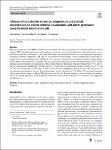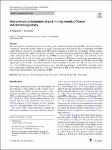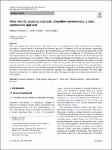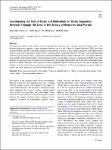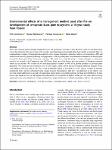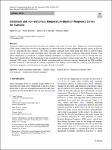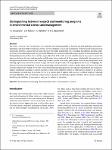Search
Author
- Osman, Ahmed I. (5)
- Chen, Zhonghao (2)
- Ricohermoso III, Emmanuel (2)
- Wang, Yongbin (2)
- next >
Subject
- LCA (6)
- ICP-MS (3)
- Artificial intelligence (2)
- CDW (2)
- next >
Date issued
Has File(s)
- true (220)
Search Results
Microbial desalination cells (MDCs) exhibited an economical value with large promises as a useful desalination treatment solution. MDCs threefold applications to efficiently treat wastewater and to produce electricity and simultaneously accomplish desalination were investigated in this work. The study examined the influence of various performance parameters including co-substrate, temperature, pH, and salt concentrations on the response of three-chamber MDCs with respect to energy recovery and contaminant removal (Phenol). The system evaluation criteria encompassed chemical oxygen demand (COD), phenol removal efficiency, Coulombic efficiency, desalination efficiency, and other system parameters such as voltage generation and power density |
The main question of the present study is how much are the former post-mining mounds (PMM) - the ancient remnants of mining of a provisional nature located in forest areas-contaminated by heavy metals (HM). To investigate if the PMM contain HM, we collected 15 soil samples from PMM and, for comparison, 15 from the surroundings - all these samples (30) were collected from a depth of 5–30 cm by soil auger. To find how deep the contamination of HM goes, we did 4 soil profiles to the depth 100 cm in four randomly selected PMM. In every soil profile, 4 soil samples were collected (16 soil profile samples). In total, 46 soil samples were analysed. Concentrations of HM were measured using spectrophotometry. Our results indicate the following: (1) PMM are not much contaminated by HM - only ... |
Decreases in shallow-water habitat area (SWHA) in the Lower Columbia River and Estuary (LCRE) have adversely affected salmonid populations. We investigate the causes by hindcasting SWHA from 1928 to 2004, system-wide, based on daily higher high water (HHW) and system hypsometry. Physics-based regression models are used to represent HHW along the system as a function of river inflow, tides, and coastal processes, and hypsometry is used to estimate the associated SWHA. Scenario modeling is employed to attribute SWHA losses to levees, flow regulation, diversion, navigational development, and climate-induced hydrologic change, for subsidence scenarios of up to 2 m, and for 0.5 m fill. For zero subsidence, the system-wide annual-average loss of SWHA is 55 ± 5%, or 51 × 105 ha/year; levee... |
This study applies novel risk measures, called Orlicz risks, to the risk and uncertainty evaluation of the streamflow discharge as a primary driver of hydrological and hydraulic processes of interest in civil and environmental engineering. We consider the mixed moving average process governing the discharge whose statistics are explicitly represented as some product of a time-scale characterizing the flow attenuation and a jump moment governing the size and frequency of jumps. The classical Orlicz risks are extended so that not only the upper tail risk but also the lower one of the jump size and attenuation of the discharge can be evaluated within a single mathematical framework. Further, the risk and uncertainty can be individually quantified in a tractable manner by the proposed O... |
Nowadays the prediction and change of waste-related behaviors represent a key topic for scholars and policy makers. The theoretical mainstays applied to waste separation behavior, such as the Theory of Planned Behavior (TPB), the Norm Activation Model and the Value Belief Norm, do not include the construct of goal in their formulation. Other goal-focused theories, such as the Goal Systems Theory (GST), lack applications on separation behavior. Recently, Ajzen and Kruglanski (2019) have proposed the Theory of Reasoned Goal Pursuit (TRGP) which combines TPB and GST. Considering TRGP has the potential to offer further insights on human behavior and, to our knowledge, there is no application of TRGP to recycling behavior yet, this paper analyses waste separation behavior of households i... |
Deciding whether to plant native or non-native trees in public urban green spaces is becoming complex and conflicted, and decisions purely based on biotic nativeness are likely to be hamstrung as climate change and rising urban heat push many native species beyond their natural ranges. Importantly, tree selection considerations by urban planners and environmental managers will have to move beyond a primary focus on securing conservation and ecological outcomes, to elucidate and engage with a growing interest in the socio-cultural values and services of urban trees. Building on emerging theoretical perspectives, this place-based study explores the role that perceptions of nativeness have in shaping people’s relationships with native and non-native urban trees and landscapes in an Aus... |
Due to the ongoing climate changes, temperate forests are increasingly exposed to fires. However, until now the functioning of post-fire temperate forest ecosystems with regard to used forest management method has been weakly recognized. Here, we examined three variants of forest restoration after fire (two variants of natural regeneration with no soil preparation—NR, and artificial restoration by planting following soil preparation—AR) regarding their environmental consequences in development of post-fire Scots pine (Pinus sylvestris) ecosystem. The study was conducted using a 15-year timespan in a long-term research site located in the Cierpiszewo area (N Poland) being one of the biggest post-fire grounds in European temperate forests in last decades. We focused on soil and microc... |
Australian summer heat events have become more frequent and severe in recent times. Temperature-duration-frequency (TDF) curves connect the severity of heat episodes of various durations to their frequencies and thus can be an effective tool for analysing the heat extremes. This study examines Australian heat events using data from 82 meteorological stations. TDF curves have been developed under stationary and non-stationary conditions. Generalised Extreme Value (GEV) distribution is considered to estimate extreme temperatures for return periods of 2, 5, 10, 25, 50 and 100 years. Three major climate drivers for Australia have been considered as potential covariates along with Time to develop the non-stationary TDF curves. |
Extreme precipitation shows non-stationarity, meaning that its distribution can change with time or other large-scale variables. For a classical frequency-intensity analysis this effect is often neglected. Here, we propose a model including the influence of North Atlantic Oscillation, time, surface temperature and a blocking index. The model features flexibility to use annual maxima as well as seasonal maxima to be fitted in a generalized extreme value setting. To further increase the efficiency of data usage, maxima from different accumulation durations are aggregated so that information for extremes on different time scales can be provided. Our model is trained to individual station data with temporal resolutions ranging from one minute to one day across Germany. Models are chosen... |
The terms “research” and “monitoring” are commonly used interchangeably to describe the data-gathering, information-generating, and knowledge-translating activities in environmental science and management. While research and monitoring share many attributes, such as the tools used, they may also differ in important ways, including the audience and their stability. In any environmental program, any potential differences between research and monitoring may be inconsequential, but distinguishing between these two activities, especially when both words are used casually, may be necessary to ensure the alignment between the tools and approaches and the expectations and goals of the program. Additionally, the importance of distinguishing between research and monitoring becomes greater whe... |

